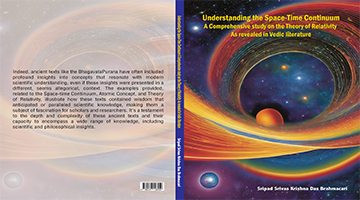In our fast-paced and often chaotic world, the pursuit of serenity and peace has become a universal aspiration. While stress and anxiety are commonplace, ancient scriptures like the Vedas and the Bhagavad Gita provide timeless wisdom that can guide us towards a more tranquil and harmonious existence. In this article, we will explore how the teachings of these Vedic scriptures offer valuable strategies for managing stress and uncovering the path to inner peace.
Understanding the stress:
In the pursuit of managing stress effectively, it is vital to gain a deep understanding of its underlying nature. The teachings of the Bhagavad Gita offer profound insights into the origins of stress. According to the Bhagavad Gita, stress often emerges from our strong attachments to the outcomes of our actions. we can point the detailed explanation of this concept:
Attachments to Outcomes: In our daily lives, we are often driven by specific desires and expectations. We set goals, work hard, and invest our energy into achieving particular outcomes, whether in our careers, relationships, or personal aspirations. These attachments can be positive, like aspiring to succeed in a professional endeavor, or more personal, such as seeking approval and recognition.
The Role of Expectations: The Bhagavad Gita emphasizes that when our attachment to the results of our actions is too strong, it can lead to a heightened sense of expectation. We anticipate that achieving a particular outcome will bring us happiness, satisfaction, and fulfillment. This attachment to desired results and the expectations associated with them can create stress when things don’t go as planned.
Setting the Stage for Disappointment: When we are overly fixated on achieving specific results, we set ourselves up for potential disappointment. If circumstances do not align with our expectations or if we face unexpected setbacks, it can lead to frustration, anxiety, and stress. The greater our attachment to these outcomes, the more significant the stress when they are not realized.
Recognizing Attachment: The Bhagavad Gita teaches that the first step in managing stress is recognizing our attachments. By acknowledging the extent to which we are emotionally invested in specific outcomes, we can begin to address the root of our stress. This self-awareness enables us to disentangle our well-being from the external circumstances we seek to control.
In essence, the Bhagavad Gita encourages us to pursue our goals and aspirations with dedication but also to cultivate a sense of detachment from the outcomes. By practicing detachment, we can better manage stress and anxiety, as our peace and well-being become less reliant on external factors. This profound insight from the Bhagavad Gita provides a valuable foundation for stress management, promoting a more balanced and serene approach to life’s challenges.
The Yoga of Action:
The Bhagavad Gita introduces the concept of “Karma Yoga,” the yoga of selfless action. By focusing on the process rather than the outcome of our actions and by dedicating our efforts to a higher purpose, we can reduce the stress associated with success or failure. This selfless approach to action leads to a more serene state of mind.
Mindfulness and Meditation:
All the Vedic literatures including the Bhagavad Gita emphasize the power of mindfulness and meditation. These practices help quiet the mind, reduce anxiety, and enhance our ability to stay in the present moment. By meditating on the divine or our true selves, we can attain a deep sense of peace.
Detachment:
The Vedas and the Bhagavad Gita encourage us to cultivate a sense of detachment. This doesn’t mean avoiding responsibilities but rather learning to do our duties with equanimity, without being overly affected by the outcomes. Detachment enables us to face challenges with composure.
Seek Guidance:
The Bhagavad Gita itself is a dialogue between Lord Krishna and Arjuna, where Arjuna seeks guidance in a moment of great stress and moral dilemma. This teaches us the importance of seeking wise counsel from mentors or spiritual guides when we face challenges and stress in our lives.
Self-Reflection and Self-Realization:
The Vedic scriptures emphasize self-realization as a path to serenity. Understanding our true nature and the interconnectedness of all beings can lead to a profound sense of peace and compassion. Regular self-reflection and introspection are keys to achieving this state.
Conclusion:
Stress is an inevitable part of life, but with the timeless teachings of the Vedas and the Bhagavad Gita, we can learn to manage it effectively and discover the path to serenity and peace. By understanding the nature of stress, practicing selfless action, embracing mindfulness, cultivating detachment, seeking guidance, and engaging in self-reflection, we can navigate life’s challenges with equanimity and discover the tranquility that resides within us. The wisdom of these ancient scriptures offers us valuable tools for managing stress and attaining a life filled with inner peace and serenity.
Hare Krishna.
Published on: Brahmacari, S. K. D. Navigating the Shadows of Society, Modern Woes: Insights and Solutions.2023.JF Inc..
Views: 25































Origin of Science
Temporal Relativity in Vedic Literature: An Interdisciplinary Analysis of Time Dilation Narratives
Acharya Kaṇāda: The Ancient Sage Who Discovered the Atom
Evidence of Vedic Sanātana Hinduism as a Global Dharma
Perception of Quantum Gravity and Field Theory in the Vedas
String Theory as Mentioned in Veda
Sanskrit’s Role in Advancing AI: A Comprehensive Study
The Vedic Model of the Mind: A Contemporary Exploration
Vedic Contributions to Geometry: Unveiling the Origins of Mathematics
Matter and Consciousness in Achintya Bhedābheda: Bridging with Quantum Physics
A Comprehensive Study of Aeroplanes and Aviation in Vedic Literature
Hydrology and the Water Cycle in Vedic Scriptures
Vedic Insights on the Speed of Light